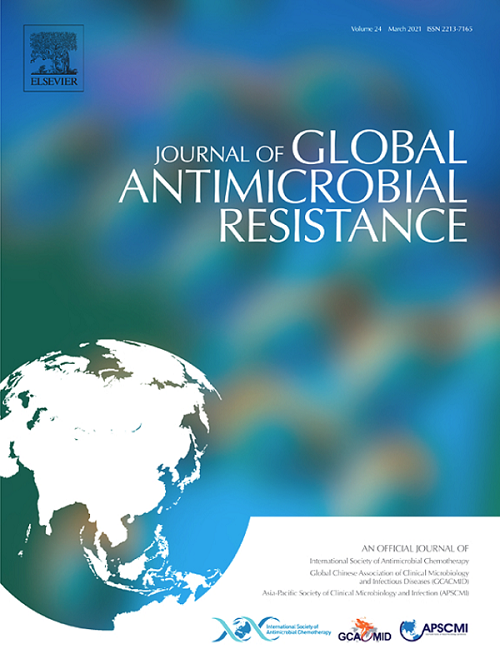Emerging epidemic of the predominant clusters of FC428-like Neisseria gonorrhoeae in Guangdong, China
IF 3.2
3区 医学
Q2 INFECTIOUS DISEASES
引用次数: 0
Abstract
Objectives
This study aimed to investigate the molecular characteristics of predominant epidemic clusters of FC428-like N. gonorrhoeae in Guangdong, China in 2022.
Methods
Minimum inhibitory concentrations (MICs) were determined for N. gonorrhoeae isolates collected from the Guangdong Gonococcal Antimicrobial Surveillance Program. N. gonorrhoeae multiantigen sequence typing (NG-MAST), antimicrobial resistance sequence typing (NG-STAR), multilocus sequence typing (MLST) sequence types (STs), and penA alleles were determined by whole-genome sequencing. The isolates were further characterised by phylogenetic analysis.
Results
A total of 537 N. gonorrhoeae isolates were analysed, molecular analysis revealed that 7.8% of the isolates carried penA 60.001 allele, which was highly resistant to ceftriaxone (88.1%) and cefixime (100.0%). The predominant STs in penA 60.001 isolates were MLST ST1903 (23,54.8%), ST7365 (11,26.2%), NG-STAR ST1143 (13,31.0%), ST233 (4,9.5%), ST1133 (4,9.5%), and NG-MAST ST22261 (10,23.8%). Among 537 isolates, of which 11.2% were resistant to ceftriaxone and 19.6% to cefixime. In western Guangdong, resistance to ceftriaxone and cefixime reached 17.3% and 26.9%, respectively. The most predominant types among ceftriaxone-resistant isolates are genetically closer to FC428 isolates, and differ from those among cefixime-resistant isolates. Phylogenetic analysis revealed that the Guangdong FC428-like isolates from 2021 to 2022 spread across the whole phylogenetic tree, but the majority were clustered within a distinct evolutionary clade.
Conclusions
FC428-like isolates in Guangdong formed a unique evolutionary clade with high cephalosporin resistance. These findings highlight the need to revise national gonorrhea treatment guidelines and prioritise the development of new antimicrobials.
中国广东出现的fc428样淋病奈瑟菌主要聚集性流行
目的:研究2022年广东省主要流行群fc428样淋病奈瑟菌的分子特征。方法:对广东省淋病奈瑟菌抗菌药物监测项目采集的淋病奈瑟菌进行最低抑菌浓度测定。采用全基因组测序法测定淋球菌多抗原序列分型(NG-MAST)、耐药序列分型(NG-STAR)、多位点序列分型(MLST)序列分型(STs)和penA等位基因。对分离株进行系统发育分析。结果:共分离淋病奈瑟菌537株,分子分析结果显示,7.8%的淋病奈瑟菌携带penA 60.001等位基因,对头孢曲松(88.1%)和头孢克肟(100.0%)高度耐药。在penA 60.001分离株中,优势STs分别为MLST ST1903(23,54.8%)、ST7365(11,26.2%)、NG-STAR ST1143(13,31.0%)、ST233(4,9.5%)、ST1133(4,9.5%)和NG-MAST ST22261(10,23.8%)。537株中,头孢曲松耐药11.2%,头孢克肟耐药19.6%。粤西地区对头孢曲松和头孢克肟的耐药率分别为17.3%和26.9%。头孢曲松耐药菌株中最主要的类型在遗传上更接近FC428菌株,而与头孢昔肟耐药菌株不同。系统发育分析显示,2021 - 2022年广东fc428样分离株分布在整个系统发育树中,但大多数聚集在一个不同的进化支系中。结论:广东地区fc428样分离株形成了一个独特的进化支系,具有较高的头孢菌素耐药性。这些发现强调有必要修订国家淋病治疗指南,并优先考虑开发新的抗微生物药物。
本文章由计算机程序翻译,如有差异,请以英文原文为准。
求助全文
约1分钟内获得全文
求助全文
来源期刊

Journal of global antimicrobial resistance
INFECTIOUS DISEASES-PHARMACOLOGY & PHARMACY
CiteScore
8.70
自引率
2.20%
发文量
285
审稿时长
34 weeks
期刊介绍:
The Journal of Global Antimicrobial Resistance (JGAR) is a quarterly online journal run by an international Editorial Board that focuses on the global spread of antibiotic-resistant microbes.
JGAR is a dedicated journal for all professionals working in research, health care, the environment and animal infection control, aiming to track the resistance threat worldwide and provides a single voice devoted to antimicrobial resistance (AMR).
Featuring peer-reviewed and up to date research articles, reviews, short notes and hot topics JGAR covers the key topics related to antibacterial, antiviral, antifungal and antiparasitic resistance.
 求助内容:
求助内容: 应助结果提醒方式:
应助结果提醒方式:


